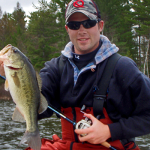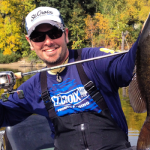By Matt Lynch
(Tennessee Valley Muskie Authority)
Often times we may look at an angler and his craft as if on an aquatic canvas, wafting with the wind and waves as he seeks out his prey. Too often we forget that on this canvas, the angler is an artist. He comes to practice his craft and test his resolution against this natatory foe which swims beneath a blank canvas.
As if to substantiate he is the master of this domain, and truly worthy to drift atop it, he begins to paint this this canvas in with details and facts as he traverses its surface. To be able to accomplish this monumental task, he relies often times the most, on one particular tool. A tool that if stripped from the hands of the late Bob Ross, would have resulted in a world with fewer “happy little trees”. This tool I speak of in the hands of the artist is his brush. And his brush is a Yamaha Jet Drive. For he seeks out this formidable prey in waters strewn with imperilment, laced with shallow rocks, logs, and shoals barely allowing themselves to fall to immersion by the waters. These treacherous environments can make or break the reputation of even the most stalwart manufacturer.
The old aphorism, “You can never have too much power.” rarely fails to stand true in the world of jet outboards and my story proved no exception to the rule. I was becoming more and more frustrated with my old jet outboards wavering fortitude with propelling my boat where I required it to travel. Although this jet drive of another exalted manufacturer had proven itself very economical and reliable it always made me feel as it I was asking more than it could deliver with its questionable output and always seemed to be straining itself for anything above idle speed. One of the last straws was finally having my family with me and muskie gear and finding it unable to get on plane, instead plowing through the water like a D10 Caterpillar.
I began my search almost immediately after with no real bias of brands. I wasn’t interested in all the pushy glamor touted by so many professional tournament anglers. I needed this new tool to excel at its trade and to do so for many trouble free years to come. It is so often we get captivated by the latest greatest motors that this professional and that professional says we need, that we may overlook important details. It’s one thing to talk about the grandeur of a motor and its reliability when one is fishing a large televised tournament and technicians and a quick tow are simply a quick phone call away. But instead I wanted to look from the perspective of those who choose their motor carefully knowing that a quick tow isn’t always a phone call away. I looked to the answer of the man who treks many miles into uncharted or rarely traveled water knowing that if his tools fail him, it may mean more than a late night getting home. It may mean he never does come home. I also looked to what dominates the boats of many guides who have to pay their own way often when re-powering a boat and who must rely on their procurement to help put food on the table. That is why after much deliberation I chose a new Yamaha F40 Jet Drive to re-power my boat. It just has to work, and has to work every time with punctuality.
It’s no wonder why we see so many Yamaha’s on the back of boats today. Everything from the little jon boat of the weekend warrior, to the man running miles from help and civilization in the wilds of Alaska, Yamaha covers the bill with tenacity unrivaled by another manufacturer. And I gotta say, the F40 does so while looking very sexy. Don’t let the 45.6 cubic inch power head hidden beneath its steamy and tantalizing cowling fool you. This beauty queen has all the fight of a disgruntled wolverine trapped in a burlap sac and delivers it with little more than a subtle purr at idle. Even at wide open throttle the attenuate growl it offers up verily betrays its inner monster. With a SOHC cam four stoke inline 3 cylinder power plant it spins the impeller of its jet pump to produce a 30 horsepower output at the nozzle. To some this may seem insignificant but if you are use to outboard jets and see the performance in person it will humble the competition. One of my best friends and fellow operator of the Tennessee Valley Muskie Authority, Cory Allen, hopped aboard for the break-in ceremony and being very accustomed to the seat of your pants rocket that is the Yamaha F70 which powers his Tuffy I didn’t expect him to be overcome with any excitement. However before we even reached the full throttle period of the break-in the look on his face said it all. The man was impressed, as was I. He too, knew well the former tenant of my transom’s worrisome performance and this was a whole new animal. At 227lbs this girl is curvy and can certainly hold her own once her electric start tells her its time to wake up.
Admittedly Yamaha offers another reason why I just couldn’t say no. Yamaha offers what is in my opinion the finest and most ergonomic tiller handle mankind has ever laid his hand upon. When engine trolling, it’s all about control, and the late great Buck Perry teaches us greatly the importance of this factor when trying to decipher the puzzle of consistently catching fish on any body of water. When you place your hand on the Yamaha Multi-Function Tiller Handle, you truly are in control and know this girl will play nice. To say I was elated the first time I turned the key would be a massive understatement. One thing you will quickly notice is the massive can’t miss shifter atop the handle within easy reach. No more leaning back over the transom to change direction, one barely has to move his hand away from the comfortable rubber coated twist throttle to do so. The coating on this twist throttle is really a coup de grace to an already smooth transition of power from hand to RPM. It provides a positive grip in all conditions and certainly warms up to your touch faster on those frigid mornings. On the F40, Yamaha was kind enough to include LED warning lights on the multi-function Tiller Handle to warn, in the unlikely event, of low oil pressure or an overheating condition to help safeguard this steamy gray vixen of the water. For the person who likes to engine troll, which at the TVMA, we certainly do, there is one final way this Siren calls us in and seduces the angler. The song of this Siren is called Variable Trolling Speed(VTS). What this does is allow the angler to adjust RPM in 50-RPM increments to better match his trolling speed to the conditions and presentation required. Two simple adjoining buttons allow this operation and you need not move your hand very far to do so from the loving embrace of your throttle.
To sum all the details and decisions up that lead me to the F40 is a long undertaking and I’ve barely brushed the surface but I do know that with the service and reputation Yamaha offers, I made the right choice. We don’t take our muskellunge driven pursuit very lightly around here and I can assure you that this artist of the water will be painting many a canvas with his new brush for years to come.
To seek addtional info about jets in general or my specific setup, or if you are interested in chasing trophy muskie in Tennessee, contact us via Facebook or Tennessee Valley Muskie Authority – Tennessee’s comprehensive fishing resource and guide service with your host, Cory Allen. The TVMA specializes in the pursuit of trophy muskies on our year-round southern fisheries. We are committed to educating, and providing the best fishing experience possible to our clients.





